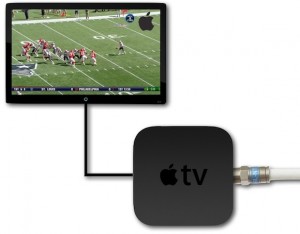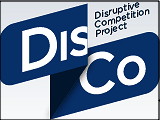Nearly six months before this week’s reveal of iPhone 6 and the Apple Watch, the Wall Street Journal reported that Apple was in talks with Comcast Corp. about “teaming up for a streaming-television service that would use an Apple set-top box and get special treatment on Comcast’s cables to ensure it bypasses congestion on the Web.” For content, the product reportedly would not only offer users access to on-demand movies, TV programs and other apps, including games, but also live Comcast cable programming. This raises a serious question whether such an arrangement would represent a procompetitive development or instead further delay a languishing 20-year federal effort to create a commercially viable retail market for cable set-top boxes (“STBs”).
There are three sets of obstacles potentially standing in the way of this initiative. First are business issues associated with customer control. As commentary noted at the time:
Back in February it seemed both Comcast and DirecTV were reluctant to allow Apple to develop a system where customers logged in using their Apple credentials instead of their pay-TV accounts. The fundamental question of who gets to have the primary relationship with the customer has played prominently in Apple’s negotiations with magazine and newspaper publishers in the past, so it makes sense that the issue would pop up again in a different medium. Given that Comcast has been investing in its own advanced set-top boxes, the cable giant is probably not ready to cede too much ground too quickly.
The second set of issues relates to whether Apple, or any content provider, should be permitted to pay for routing of its IPTV traffic as a managed service, receiving priority handling for the packets involved, from ISPs. That is a subset of the network neutrality debate, commonly referred to as “paid prioritization,” that continues to rage before the FCC and Congress.
 Yet a third set of issues has received scant attention in the business media. That is, how would an Apple STB deal with the 1996 legal mandate that so-called “navigation devices” be available for retail purchase by consumers, in other words unbundled from cable television and broadband service? Apple is known to have the most popular, addictive and tightly integrated ecosystem of all technology companies. The company is famous for steadfastly protecting this closed ecosystem and declining to make its hardware, or most software, interoperable with other platforms. The devices and software Apple sells are designed to work well with each other and sync easily so that preferences and media can be copied or shared with multiple devices without much effort. Applications work on many devices at the same time — even with a single purchase — and user interfaces are very similar across devices. Sure, out of necessity Apple offers iTunes software for Windows (supporting both the iTunes Store for music and video purchases and iPhone syncing on Windows PCs), but at their core most Apple products work best, if at all, only with other Apple products.
Yet a third set of issues has received scant attention in the business media. That is, how would an Apple STB deal with the 1996 legal mandate that so-called “navigation devices” be available for retail purchase by consumers, in other words unbundled from cable television and broadband service? Apple is known to have the most popular, addictive and tightly integrated ecosystem of all technology companies. The company is famous for steadfastly protecting this closed ecosystem and declining to make its hardware, or most software, interoperable with other platforms. The devices and software Apple sells are designed to work well with each other and sync easily so that preferences and media can be copied or shared with multiple devices without much effort. Applications work on many devices at the same time — even with a single purchase — and user interfaces are very similar across devices. Sure, out of necessity Apple offers iTunes software for Windows (supporting both the iTunes Store for music and video purchases and iPhone syncing on Windows PCs), but at their core most Apple products work best, if at all, only with other Apple products.
As a business strategy, the closed Apple ecosystem experienced some very bad years in the mid-1990s, yet today has propelled Apple into its current status as the world’s most valuable corporation. As a legal and policy matter, though, things could be quite different.
The gist of the 1996 commercial availability requirement was that the FCC should devise or adopt standards allowing interoperability among STBs, much like the voluntary DOCSIS standard does for cable modems, in order to develop a retail market so that consumers would not be required to buy or lease an STB from their cable provider. The agency has tried, but admits it “has not been fully successful” in those efforts, which today revolve around CableCARD, the security devices used in conjunction with STBs to perform authentication (or “conditional access”) functions for pay cable programming like video-on-demand and HBO. That is in part because many device manufacturers had already abandoned CableCARD well before the FCC’s ban on lease of integrated cable STBs became effective in 2007. Even a 2011 directive that cable companies “ensure that consumers are treated similarly, whether they choose to buy a retail device or rent a device from their cable provider,” has proved largely fruitless. TiVo, the DVR pioneer, supports CableCARD compatibility for its product line, but the numbers are revealing: only about 620,000 CableCARDs for retail devices have been deployed since the FCC rules were promulgated, versus nearly 47 million cable system-distributed set-top boxes.
The good part about an Apple STB is that, if the company can work out technical compatibility issues with cable providers, it is very clear Apple would sell its devices directly to consumers in Apple Stores and online. As a competitive matter, that might increase business pressure on large cable firms to adopt open standards so that third-party manufacturers could produce STBs as easily as they do cable modems and WiFi routers. A bit of that pressure appears already to have been felt, as Comcast and TiVo reached agreement in July on a plan to develop “a two-way non-CableCARD security solution that will enable retail devices to access the full Comcast lineup of linear and VOD programming,” to be made available on “commercially reasonable terms” so the new protocol “can also be supported in other compatible customer-owned devices.” The potentially bad part about an Apple STB, however, is that if as anticipated it is tightly integrated with the Apple ecosystem — think special edition of an Apple TV device unique to Comcast — it could substitute the closed Apple product suite for the closed STB devices that today come largely from cable providers themselves. Trading one de facto sole source of cable STBs (cable systems) for another (Apple) surely appears neither procompetitive nor consistent with the commercial availability mandate.
Yet from a parallel angle, intellectual property and antitrust law do not prevent, or even discourage, firms from setting up closed technologies and adopting proprietary standards. Indeed, some have argued that proprietary standards are a superior approach to fostering technical innovation. As a result, absent some unusual circumstances, if a manufacturer purposefully designs new products to be incompatible with its competitors, the antitrust and IP laws are indifferent. (That is why the antitrust lawsuits claiming that Apple unlawfully monopolized by limiting music and app downloads for the iPod and iPhone to its own services have all failed to date.) From that perspective, the Comcast-TiVo agreement to move beyond CableCard for integrated STBs offers the possibility of a true competitive market test between proprietary and open STBs. On the other hand, where vertical integration and closed standards are used in markets in which a firm may have market power, the regulatory response could well be negative. We know the FCC is looking closely at the Comcast/Time Warner Cable proposed merger. If Comcast and Apple teamed up on a proprietary STB, that enforcement threat from 2011 might finally ripen into reality, notwithstanding the open TiVo initiative.
One alternative is for Congress to concede defeat and repeal the commercial availability mandate of the 1996 Telecommunications Act. Doubtless Comcast and other cable providers would be overjoyed, because the rules do somewhat circumscribe their ability to easily roll out new features for consumers. The bugaboo has always been and remains security of programming, with well-founded fears that an open market would increase television piracy. Yet as cable has transitioned almost fully to digital transmission and routinely encrypts VOD and pay cable services, isn’t that concern largely obsolete? If that is correct, one would anticipate a new round of FCC rulemaking and, in the case of an Apple-Comcast set-top box, a complex and contentious regulatory review. Of course, as noted an Apple STB would certainly be “commercially available” at retail. Since that was the still unrealized objective of the 1996 Act, why should government stand in the way? Another STB sold at retail is better than the numbers reported about CableCARDs’ dismal retail penetration.
The commercial availability issue for cable STBs is complicated and has a convoluted history. These observations just scratch the surface. But if Apple and Comcast move forward with the partnership first reported in late March, there seem to be plenty of consumer electronics firms and policy advocates who would be incentivized to drill down in opposition to such a development. Expect a fight, in other words.
Originally prepared for and reposted with permission of the Disruptive Competition Project.


Leave a Reply